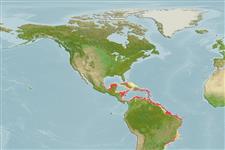>
Clupeiformes (Herrings) >
Engraulidae (Anchovies) > Engraulinae
Etymology: Cetengraulis: Greek, ketos = a marine monster, whale + Greek, eggraulis, -eos = anchovy (Ref. 45335).
More on author: Cuvier.
Environment: milieu / climate zone / depth range / distribution range
Ecologie
marien; brak water; diepte 10 - ? m. Tropical; 23°N - 28°S, 98°W - 32°W (Ref. 189)
Western Atlantic: in the Antilles, from Cuba southward; Costa Rica south and east to Colombia and Venezuela, Trinidad south to Itapema, Santa Catarina, Brazil.
Lengte bij maturiteit / Grootte / Gewicht / Leeftijd
Maturity: Lm 13.7 range ? - ? cm
Max length : 20.5 cm TL mannelijk / geslacht onbekend; (Ref. 125970); common length : 15.0 cm TL mannelijk / geslacht onbekend; (Ref. 5217); max. gepubliceerd gewicht: 140.58 g (Ref. 125970)
Dorsale stekels (totaal): 0; Anale stekels 0; Anale zachte stralen: 18 - 24. Head large and deep. Snout short and pointed, about 2/3 eye diameter; maxilla moderate, tip blunt, just failing to reach lower jaw articulation; fine and numerous lower gill rakers, increasing in large fishes; no gill rakers on posterior face of third epibranchial. Branchiostegal rays 8, long and slender; branchiostegal membrane broad. Silver stripe disappearing at about 10 cm SL (Ref. 189). Dusky dots on upper surface of head and snout, series of large black dots along base of anal (Ref. 37032).
Occurs inshore and forms quite large schools. Enters brackish waters of lagoons and estuaries and can tolerate salinities of 10.32-31 ppt (Santa Cruz Canal, Pernambuco, Brazil). A filter-feeder presumably on both phytoplankton and zooplankton. Spawns off the Araya Peninsula, Venezuela from October to January, with a distinct peak in mid-November. Eggs are oval, spawned at 0230-0500 hours along shoreline out to about 1.5 km and hatching at about 20-24 hours later.
Whitehead, P.J.P., G.J. Nelson and T. Wongratana, 1988. FAO Species Catalogue. Vol. 7. Clupeoid fishes of the world (Suborder Clupeoidei). An annotated and illustrated catalogue of the herrings, sardines, pilchards, sprats, shads, anchovies and wolf-herrings. FAO Fish. Synop. 125(7/2):305-579. Rome: FAO. (Ref. 189)
Status op de Rode Lijst van het IUCN (Ref. 130435)
Gevaar voor de mens
Harmless
Gebruik door de mens
Visserij: van minder commercieel belang; aas: usually
Meer informatie
ReferentiesAquacultuurAquacultuurprofielKweeklijnenGeneticaElectrophoresesErfelijkheidZiektesVerwerkingNutrientsMassaconversie
Tools
Speciale rapporten
Download XML
Internetbronnen
Estimates based on models
Preferred temperature (Ref.
123201): 24.4 - 28, mean 27.4 °C (based on 76 cells).
Fylogenetische diversiteitsindex (Ref.
82804): PD
50 = 0.7500 [Uniqueness, from 0.5 = low to 2.0 = high].
Bayesian length-weight: a=0.00490 (0.00392 - 0.00612), b=3.23 (3.17 - 3.29), in cm total length, based on LWR estimates for this species (Ref.
93245).
Trofisch niveau (Ref.
69278): 2.1 ±0.07 se; based on food items.
Weerstandsvermogen (Ref.
120179): Gemiddeld, minimale populatieverdubbelingstijd 1,4-4,4 jaar (K=0.13-0.22; Fec=8,189 (batch fecundity)).
Prior r = 0.55, 95% CL = 0.37 - 0.83, Based on 3 stock assessments.
Fishing Vulnerability (Ref.
59153): Moderate vulnerability (44 of 100).
Climate Vulnerability (Ref.
125649): Moderate to high vulnerability (50 of 100).
Nutrients (Ref.
124155): Calcium = 189 [109, 487] mg/100g; Iron = 1.52 [0.77, 2.95] mg/100g; Protein = 18.3 [16.7, 19.9] %; Omega3 = 0.389 [0.196, 0.833] g/100g; Selenium = 31.4 [14.3, 73.9] μg/100g; VitaminA = 24.9 [5.4, 82.9] μg/100g; Zinc = 2.65 [1.77, 4.20] mg/100g (wet weight);
